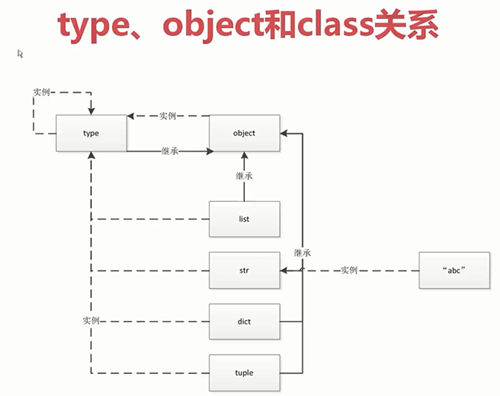2.1 python中一切皆是对象
动态语言和静态语言的区别,Python的面向对象更彻底
同时动态语言,代码的灵活性高
没有编译(检查)的过程,错误只有在运行起来后才会发现
函数和类也是对象,属于python的一等公民
1. 赋值给一个变量
2. 可以添加到集合对象中
3. 可以作为参数传递给函数
4. 可以当做函数的返回值
def ask(name="lewen"): print(name)
class Persoon(object): def __init__(self): print("lewen") obj_list = [] obj_list.append(ask) obj_list.append(Persoon) for item in obj_list: print(item())
lewen
None
lewen
<__main__.Persoon object at 0x0000029B7B3BBA20>
2.2 type、object和class的关系
type 的用法 1:生成一个类 2:反回一个对象是什么类型
>>> a = 1 >>> type(a) <class 'int'> >>> type(int) <class 'type'> >>> b = "abc" >>> type(b) <class 'str'> >>> type(str) <class 'type'> >>> class Student: ... pass ... >>> stu = Student() >>> type(stu) <class '__main__.Student'> >>> type(Student) <class 'type'>
type->int->1
type->class->obj
type是用来生成类的
>>> type(Student) <class 'type'> >>> Student.__bases__ (<class 'object'>,) >>> class MyStudent(Student): ... pass ... >>> MyStudent.__bases__ (<class '__main__.Student'>,) >>> type.__bases__ (<class 'object'>,) >>> type(object) <class 'type'> >>> object.__bases__ () >>> type(type) <class 'type'>
# object 是最项层基类
# type 也是一个类,同时type也是一个对象
一切都继承自object,一切皆对象
type 自己是自己的实例(内部通过指针指向同一个内存块)
2.3 python中的常见内置类型
对象的三个特征: 身份(对象在内存中的地址) In [1]: a=1 In [2]: id(a) Out[2]: 140714948027216 类型(什么类型的对象) 值 None(全局只有一个) 数值:int float complex bool 迭代类型 序列类型 list bytes、bytearray、memoryview(二进制序列) range tuple str array 映射(dict) 集合:set ,frozenset 上下文管理类型(with) 其他: 模块类型 class和实例 函数类型 方法类型 代码类型 object对象 type类型 ellipsis类型 notimplemented类型
